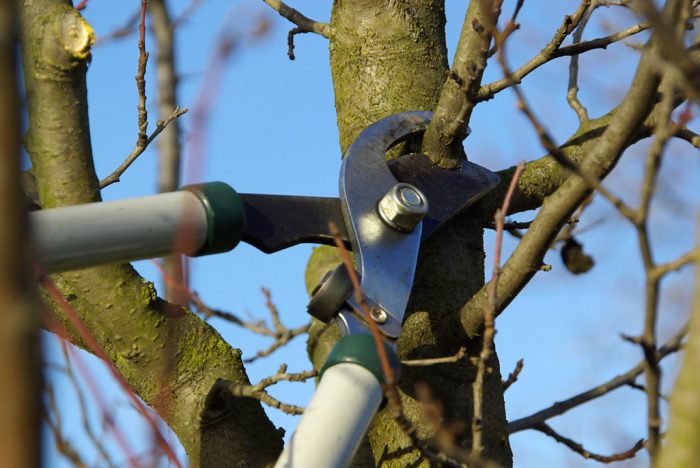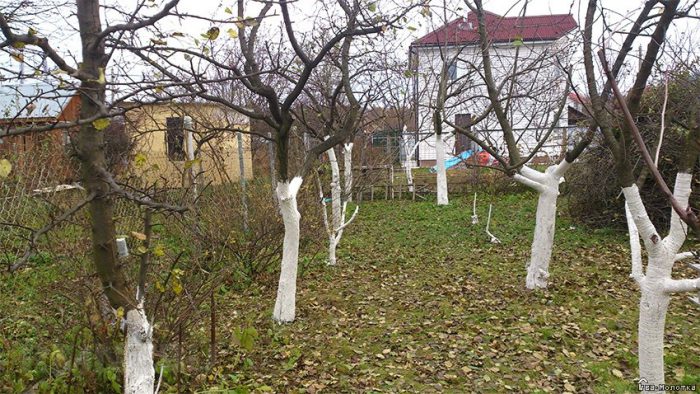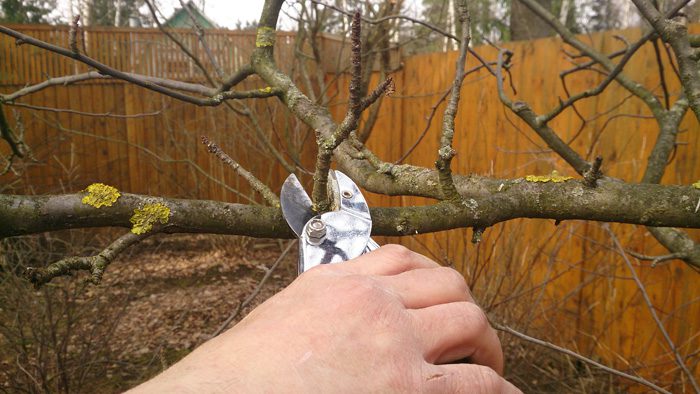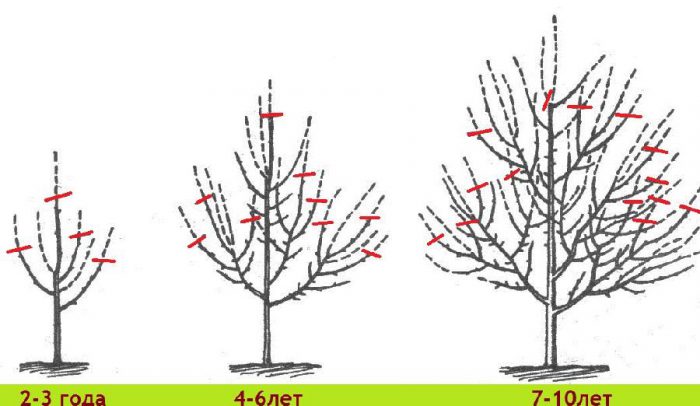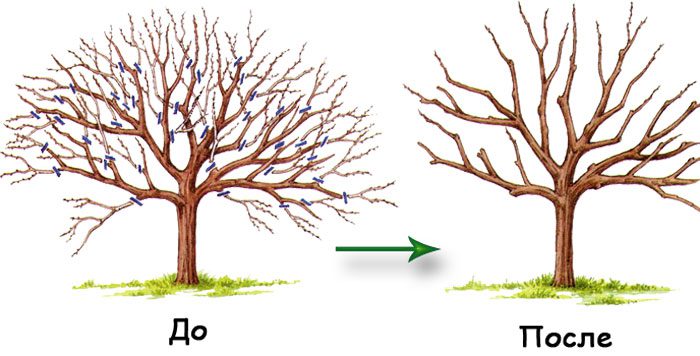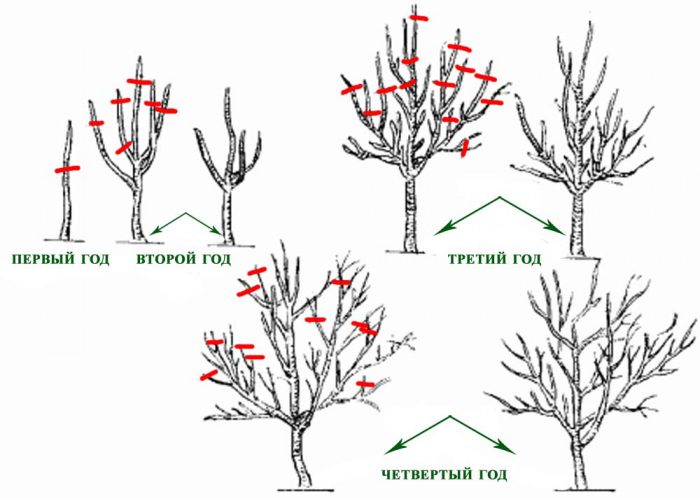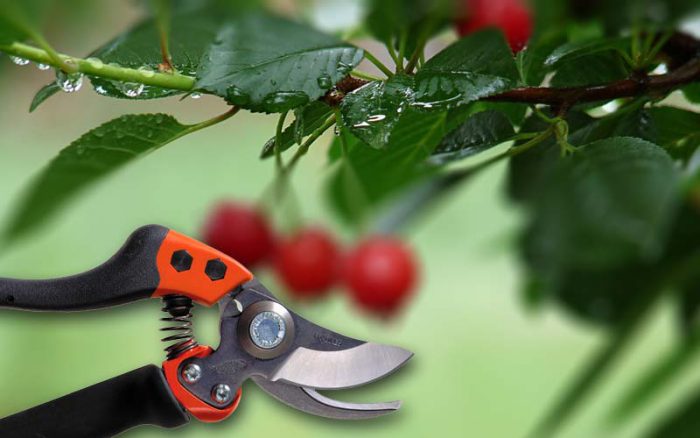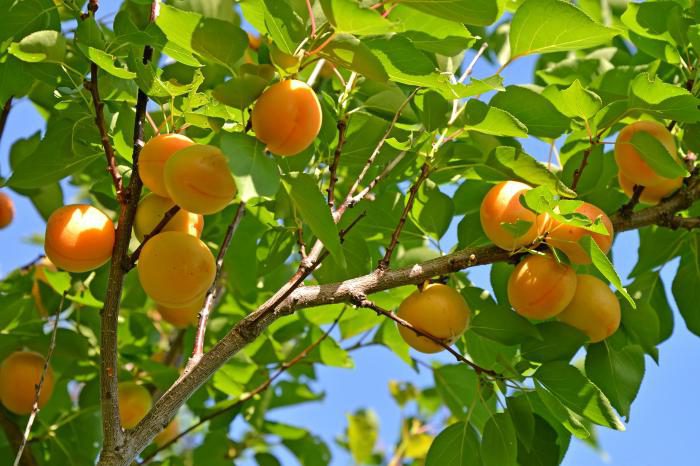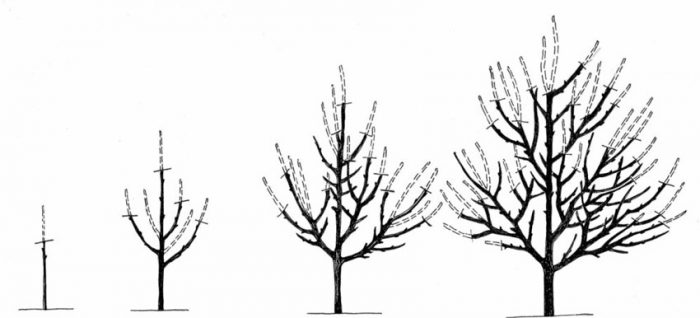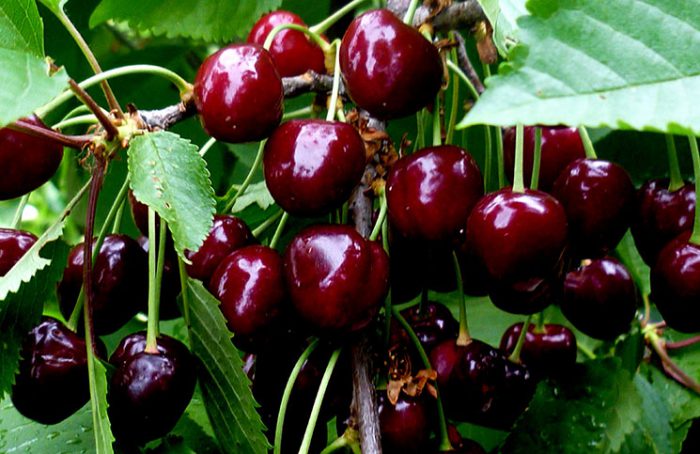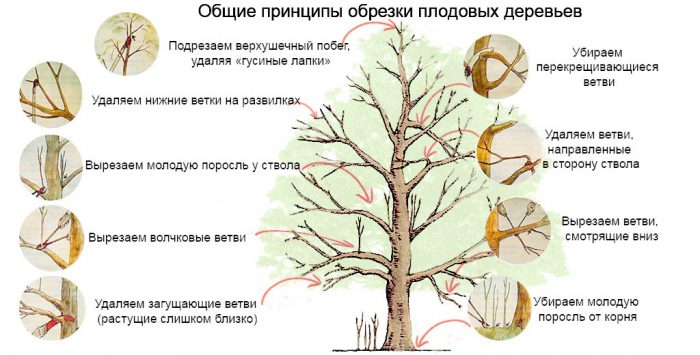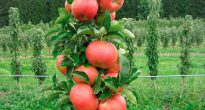It is necessary to take care of garden trees throughout the year. The correctness and timeliness of care directly affects how rich the harvest will be and how many years the garden tree will live. Pruning trees is of no small importance, because it depends on it how correctly the crown of the plant will be formed. It is necessary to begin the formation of the crown already in a very young plant, its main task is to stimulate the strongest branches to grow, as well as to fruiting, while those that interfere with growing in the wrong direction, as well as sick, injured and old ones, are necessary cutting down. In order for the tree to have an even distribution of strength, as well as nutrition, it is necessary not only to feed it in a timely manner and protect it from harmful insects and various diseases, but also to systematically and correctly cut it in the fall. So, on those horticultural crops on which there is a well-formed crown, a larger number of fruits grow, and they are of the highest quality.
Content
Pruning fruit trees in autumn
First you need to figure out what pruning is? This is the process of removing an entire shoot or a branch or part of it. This method of care is used for both fruit trees and ornamental trees and shrubs. Pruning is involved in regulating the growth, development and fruiting of these plants. The purposes of pruning can be both formative and sanitary, since a tree or shrub after this procedure is freed from those branches that can harm it. If the tree is old enough, then gardeners use rejuvenating pruning, after which the plant gains new strength, while the quantity and quality of the fruit remains practically at the same level. This procedure is recommended to be carried out in the spring and autumn, but there are times when it is simply necessary for garden culture in the summer months.It should be noted that pruning a tree in the fall is possible only if the winter is rather mild and warm in this area. In the northern regions, experts advise to carry out this procedure in the spring. The fact is that a sharp drop in air temperature after autumn pruning leads to the fact that in those places where the branches were cut, the bark freezes, and the wood also dries up, and the result is the death of the plant. There are types of horticultural crops that need to be pruned 1 or 2 times a year, but there are also those that do not need such frequent pruning. Pruning, like other agricultural techniques, has certain rules. So, you just need to know when and how a certain garden crop is pruned.
Features of pruning an apple tree
What time to trim
Pruning of apple trees is done in spring, and sometimes in summer, when ripening apples have a lack of light due to a too dense crown. And it is also held in the autumn. In the spring, before the sap flow begins, the branches that have frozen over the winter are removed, and also at this time they form a crown. In autumn, the apple tree is pruned in November and, as a rule, the crown is sanitized. In this case, pruning in the fall can begin only after the end of the leaf fall. The columnar apple tree should be pruned either in the first days of summer or before winter.
Autumn pruning
In the autumn, you need to remove those branches that are old, injured, sick or with traces of decay. Since the plant is dormant at this time, this procedure does absolutely no harm to it.
An approximate plan for an autumn pruning of an apple tree:
- first you need to remove large branches that are injured or dry;
- from the branches growing very close to each other, the strongest should be left, and the rest should be removed;
- cut branches growing at an acute angle;
- the places of the cuts must be covered with paint on linseed oil or garden varnish, while the processing of dry branches is carried out immediately, and young ones - after 24 hours;
- branches that have been cut must be destroyed.
If the apple tree is young, then with the help of a pruner, only weak pruning is done to it, while the growth of the current year should be shortened by ¼ part. After that, these specimens are not pruned for 3-5 years, cutting off only dried and injured branches. However, this is only if the tree does not grow in height too quickly. Those apple trees that are 5-6 years old need pruning of medium intensity - strong branches are shortened by 1/3 of their length. Old apple trees are pruned for rejuvenation in 3 stages. So, in the first year, you need to remove about 1/3 of all old branches, in the second year another 1/3 of the old branches, and the remaining 1/3 after another 1 year. It is worth considering that the pruning shears cannot cope with adult powerful branches; here you cannot do without a saw. It should also be remembered that the tools that are used for pruning branches must be very sharp and should be disinfected.
How to prune a columnar apple tree
Regarding the care of columnar apple trees, it must be remembered that the more intensive the pruning is, the faster and better the remaining branches will grow. In the event that you cut more than ½ part of the branch, then out of those 3 or 4 buds that remain, strong shoots will grow next spring. If less than ½ part of the branch is removed, then of the 5-7 buds that remain, 5-7 medium-sized shoots will grow. It is forbidden to cut off the central conductor of the column, otherwise branching of the crown will begin.If, when forming, they want to achieve a columnar crown, then after planting the seedling, its crown shoot must be tied to a support. From the side shoots, the fruit links should be formed. Excessively strong shoots must be cut into a ring, because they may delay the growth of the conductor. After the young shoots grow, they form the skeleton of the crown.
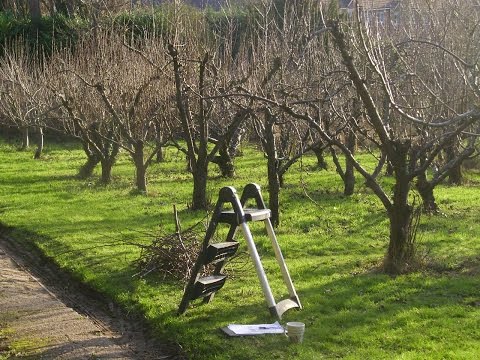

Watch this video on YouTube
Features of pruning pear tree
When to prune a pear
Those gardeners who still have too little experience believe that you need to prune a pear in the same way as an apple tree, but they are wrong. The pear tree, like the apple tree, should not be pruned annually. For sanitary purposes, you can trim the pear in the fall only if it is still warm outside. In the same case, if frosts have already come, this procedure must be postponed until next spring, since pruning of a pear tree at sub-zero temperatures is not performed. If you nevertheless cut off the branches, then the cut sites will not be able to heal, and the branches themselves will freeze and die. The best time to prune this garden crop is in spring, when it will be warmer than 8 degrees outside. In the case when a tree needs to be pruned in the fall, this can only be done in September. During pruning carried out in order to form the crown, it must be remembered that the pyramidal shape is more convenient for harvesting fruits.
Pruning pears in autumn
The formation of the crown of a tree should be started from the first year of its life, while it is necessary to immediately highlight the skeletal branches, because this will allow the crown to develop not only correctly, but also symmetrically. Pruning of annual plants is carried out at a height of 40 to 50 centimeters from the soil surface. In those pears that are 2 years old, it follows from the existing 6-8 lateral branches to leave only 3 or 4, which will take on the role of skeletal ones. They should be trimmed at the same level. The conductor should be trimmed 20 centimeters higher than the skeletal branches. Autumn pruning of mature pear trees is usually done for sanitary purposes only. So, at this time, you should cut off the branches that thicken the crown, as well as injured and sick. It is also recommended to shorten the crown and annual shoots by 1/3 part, but only if the pear tree stretches up too much, this helps to strengthen the plant, as well as strengthen branching, while the buds will begin to develop more quickly. But at the same time, try not to disturb the shape of the crown, which should be pyramidal, during the procedure. After the pruning is finished, it is necessary to smear the places of the cuts, as well as the existing cracks and damage on the surface of the bark with garden pitch. In this case, adult dry branches must be processed immediately, and young ones - after 24 hours.
Rejuvenating pruning of an old pear tree begins by shortening the top. However, if the annual pruning was done correctly, then the crown should be at the optimum height. In this case, it is only necessary to thin the crown, for this, all old and dried up branches are cut out, as well as those that do not bear fruit and grow at an acute angle or parallel to the trunk, the same shoots that remain must be cut off by ¼ part. Processing must be done with paint made on drying oil, or garden varnish. Such pruning for old trees is recommended in spring, since in this case the plant will tolerate it less painfully, but this procedure must be carried out before the buds wake up, and the air temperature outside should be at least 5 degrees.
Features of pruning plum
When to trim plums
Plums should also be pruned, like other horticultural crops, and this procedure is performed when necessary at different times of the year.Spring pruning is carried out before the buds open, at this time those parts of the branches that are frozen should be removed, and it is also necessary to prepare the plum for a period of active growth, forming a crown. In the summertime, if there are too many fruits, pruning may be required in order to prevent branch breakage. After the end of leaf fall in the autumn, it is necessary to prepare this garden culture for wintering.
Pruning plums in autumn
By pruning plums in the fall, the gardener not only prepares them for the coming winter, but also helps to increase yields. After the plant stops growing and all the leaves fall off, the plant begins to prepare for sleep. At this time, injured, dry, insect-damaged and diseased branches should be cut from the tree, and the top should also be shortened, but this is only if the tree's height exceeds 250 centimeters. After that, you need to shorten overly fast growing shoots, as well as cut off competing shoots, because in spring they will begin to grow and this will lead to thickening of the crown, which will make the light flow much worse. In young plums, the upper and lateral shoots should be shortened by no more than 1/3 part, while the branches that grow inside the crown must be cut off completely. Pruning of old branches is carried out in the spring, but if desired, during autumn pruning, you can remove the stem branches that have not borne fruit this year, as well as cut off dry or diseased shoots. Those branches that have been cut must be destroyed. Places of cuts must be processed. If the plum tree is old, it is better to postpone pruning until spring. The fact is that the wounds on them no longer heal so quickly, and in most cases gum begins to flow out of them, as a result of this, the onset of frosts can ruin a plant that could bear fruit for many more years.
Cherry pruning features
When to prune cherries
Cherries should not be pruned every year. If there is a need for formative or rejuvenating pruning, then this procedure should be carried out in the spring. In the fall, pruning can only be carried out for sanitary purposes. In the event that the winters are mild and warm, then in such areas the plant can be cut in October. And in the northern regions, where frosty winters are observed, autumn pruning must be done in September. You can start cutting the plant immediately after the end of the leaf fall, but at the same time, if frosts should begin in the near future, then this procedure should be postponed until the spring.
Pruning cherries in autumn
Those seedlings that are not pruned for only 1 year in autumn, the fact is that they are not able to recover quickly, and the onset of frost can destroy them. In older cherries, all but the 5 strongest branches should be cut out, which should be directed to the sides. Moreover, they should grow no closer than 10 centimeters from each other. Sanitary pruning of adult cherries is carried out only if necessary, while it is necessary to cut dry, injured, as well as diseased branches. In autumn, all the growth should be cut out, because it makes the plant weaker, while in winter small rodents, as well as various pests, like to hide in it. In the case when the plant is rooted, its growth is quite suitable for planting, because it is able to preserve all the varietal characteristics of the parent plant. In a grafted plant, the shoots should not be used for planting, and it must be removed, as it can cause significant harm to the cherry. Formative pruning of young cherries is done in the spring. At the same time, pruning of old plants is also postponed, which is carried out in order to rejuvenate them.
Features of pruning apricot
When to prune an apricot
Apricot pruning is done in spring, summer and autumn.At the same time, pruning in spring should be thorough, it includes formative, sanitary and, if necessary, rejuvenating. In the summer, the plant is pruned only when there is a danger that the branches will break off due to the large number of fruits. In autumn, pruning is carried out for sanitary purposes, it prepares the plant for the coming winter.
Pruning apricot in autumn
Before you start pruning the branches, you need to think about what kind of shape the crown of the plant should have - tiered or tiered. In the event that there is not very much space in the garden, then it is recommended to give the apricot crown a cupped shape; for this, the branches should be shortened by about ½ part. In autumn, the apricot needs sanitary pruning, for this you need to remove injured, sick, dry branches, and you also need to thin out the crown, for this you need to remove those branches and shoots that grow inward. But at the same time, it should be remembered that such a plant is very fond of heat; therefore, deep cuts cannot be applied. If, nevertheless, this happened, then the wound should be smeared with copper sulfate, and then with garden pitch to prevent gum from flowing out.
Peach pruning features
When to trim a peach
Peach pruning can be done in summer, fall and spring. In spring, the plant needs formative pruning, and those branches that have been damaged by frost should also be removed. At the same time, if necessary, old peaches are rejuvenated. In the summer, the plant is pruned if necessary. In the fall, the peach must be prepared for the coming winter.
Peach pruning in autumn
In the autumn, it is necessary to cut off all branches that are not needed, as well as those that have been damaged by pests or diseases. The cut branches must be destroyed, do not forget to coat the cut points on the plant with oil paint or garden varnish.
Features of pruning cherries
When to prune cherries
Formative pruning should be done in the spring. In the fall, it is necessary to carry out sanitary, as well as mandatory anti-aging pruning (most experts advise). But there is also such an opinion that in the autumn, pruning should be done only in extreme cases, to get rid of the plant from the branches injured and affected by disease or pests. If this plant is cut very hard in the fall, then this can lead to a slowdown in its fruiting. Which of the options for autumn pruning of cherries to choose, the gardener himself must decide. For example, in the fall, you can do a rejuvenating pruning, but if something does not suit you in the state of the plant, then postpone this procedure until spring for the next year.
Pruning cherries in autumn
Experts advise to give the crown of the plant a conical shape, while the base should be wide. In this case, the plant will have enough light and heat, and air circulation inside the crown will also improve. And if desired, the crown can be cupped or in the form of a tier. In autumn, when leaf fall ends, it is necessary to remove all injured, dry and diseased branches and stems. For rejuvenation, you need to cut out on the ring those branches that are 6-8 years old, while the places of the cuts must be smeared with oil paint or garden varnish.
Pruning other garden trees
It should be remembered that the main pruning of various fruit crops should be done in spring, with the exception of the apple and pear tree. At the same time, it should be above zero on the street, but you need to catch it before the kidneys swell. The fact is that in the warmth, wounds on these plants heal better and faster. In autumn, however, it is most often recommended to delete only unnecessary branches. This pruning principle is applicable not only to the plants described above, but also to sea buckthorn, cherry plum, mulberry, quince, irga, viburnum, etc.
Pruning techniques:
- Kidney cut - this will help to change the growth of the branch and direct it in the right direction. On a one-year-old stem, you need to find a bud that looks in the direction you need. Then a branch is cut off near it at an angle of 45 degrees, so that the stump on the opposite side of the stem from the bud is not too long (the length of the thorn is about 1.5–2 centimeters). The fact is that a longer stump most often dries up, and the bud does not wake up in spring.
- Ring cut - when removing an unnecessary branch, it is cut out entirely along the outer edge of the ring (a special influx of bark at the junction of the cut branch with the one that remains). This type of pruning will help make the side branch the main branch.
There are several different types of pruning used for horticultural crops, namely: regulating, restorative, shaping, rejuvenating and sanitary.
On the places of cuts and wounds, a garden pitch is smeared, while the layer should be about 0.3-0.5 centimeters thick. Currently, experts are increasingly advising to replace this product with latex paint, which contains copper salts, or you can use "artificial bark" - this product accelerates recovery processes, and also protects the wound from excessive drying, as well as from the ingress of pathogenic microorganisms and water.
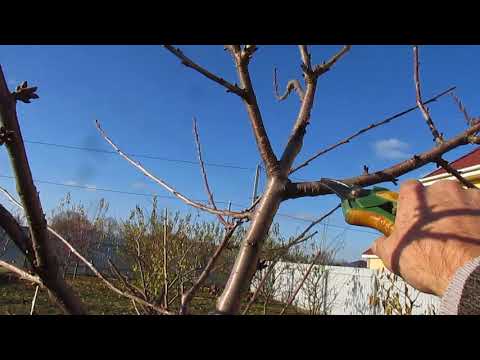

Watch this video on YouTube

